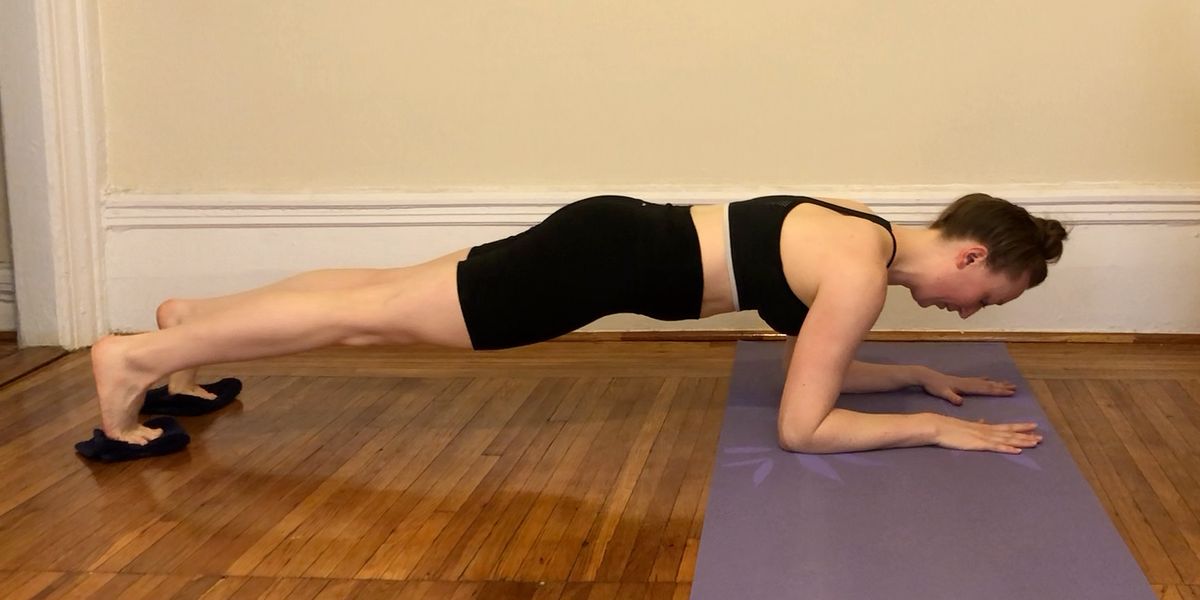Six Personal Trainer-Approved Exercises You Can Do With Just A Hand Towel
As a dancer and personal trainer, I’m used to spending most of my time in the studio or gym. While I’m really missing those places, I’m glad to stay in to help keep myself and others safe—and I’m taking advantage of what I’ve learned from years of training clients in their apartments using minimal equipment.
With a little creativity, lots of things you already have at home make great fitness props. First up: six dancer-friendly exercises you can do with just towels.
You’ll want two small hand towels, or some kind of similar cloth. (Paper plates can work, too!)
1. Body saw
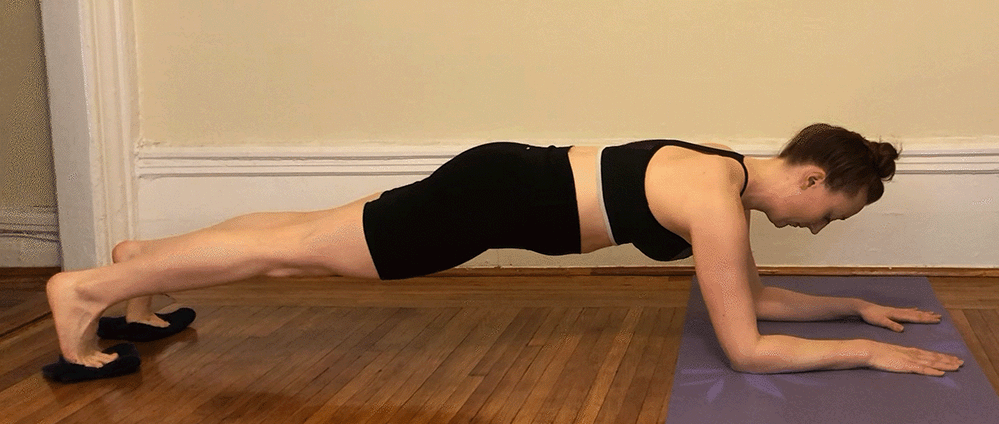
Start in a forearm plank position with a towel under the ball of each foot. For comfort, you can place your forearms on a yoga mat or blanket.
Keeping your abs engaged and spine neutral, press backward so that your feet slide back, and then pull forward. That’s one rep.
Do 1-3 sets of 6-10 reps.
Tips and tricks:
Make sure you can maintain your plank position with a neutral spine the entire time. Try to avoid dropping the pelvis down toward the floor or curving the back up toward the ceiling. If you’re having trouble maintaining your plank, keep the range of motion smaller, or cut down on the number of reps.
Why it works for dancers:
This is an advanced core exercise great for building lumbar stability, especially if you have a tendency to hyperextend your lower back. (Just be extra-mindful of your form!) It also helps build shoulder strength and stability, good for a supported port de bras and safe inversion work.
2. Heel slides

Lying on your back, start with knees bent and a towel under each heel. For comfort, you can place your upper back on a yoga mat or blanket (just make sure it won’t slide).
Squeezing your glutes, lift the hips up into a bridge position.
Slide both heels away from you until legs are straight, or as straight as you can get them, keeping your hips as lifted as possible. Then draw back in. That’s one rep.
Do 1-3 sets of 6-10 reps.
Tips and tricks:
Make sure the lift comes from your glutes, not your lower back. To avoid hyperextending through the spine, think of reaching your tailbone toward the knees. Keep your feet parallel—don’t let the toes turn out.
Why it works for dancers:
Building hamstring strength is an important component in preventing hamstring injuries, which are all too common in dancers. Plus, if you focus on maintaining your parallel alignment, this will help you keep your knees tracking over your toes in plié.
3. Reverse quadruped crawl
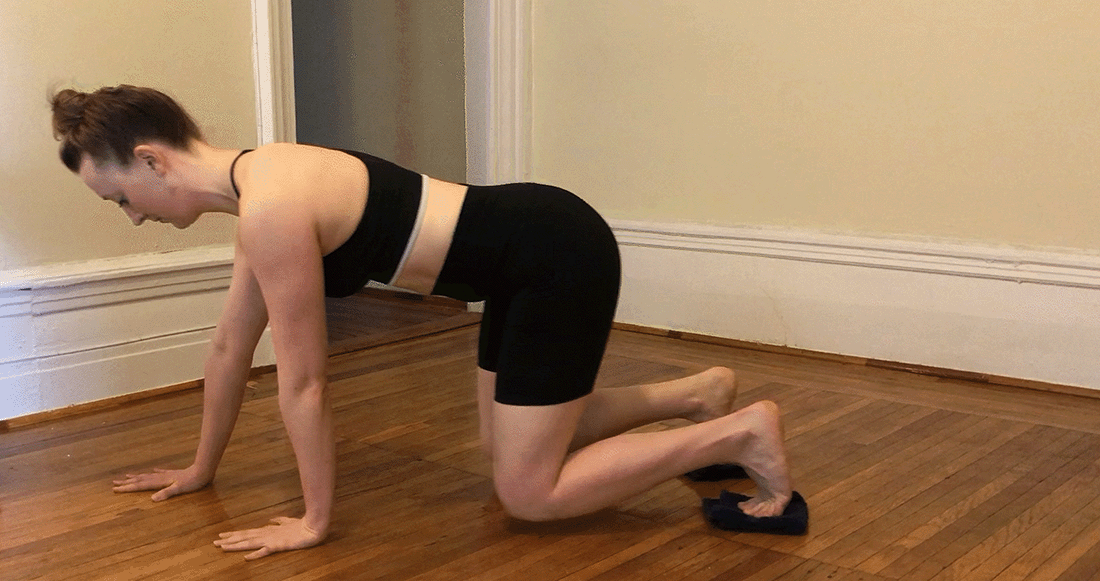
Start in a quadruped position with your hands under your shoulders and knees under your hips, with a neutral spine, abs engaged, and a towel under the ball of each foot. Make sure there’s space behind you—this exercise is great for a long hallway.
Lift the knees up so they hover about an inch off the floor.
Start to take backward steps with the hands, alternating sides, so that your body slides backward. Maintain your neutral spine and keep the knees lifted as you glide backward.
Crawl for 15-30 seconds, for 1-3 sets.
Tips and tricks:
Think of pushing the floor away with your hands, the way you’d push open a door. Don’t let your chest sink down toward the floor. There will be some shifting of your weight, but try not to let your shoulders or hips rotate. Imagine that your back is a table that you have to keep level. Don’t let your tail tuck under—keep the natural arch in your lower back, but draw the belly button in to support it.
Why it works for dancers:
This is a great exercise for pelvic and spinal stability, as well as ab strength. It also targets the serratus anterior, which helps with shoulder stability in partnering, inversions and supported port de bras.
4. Reverse lunge with slide
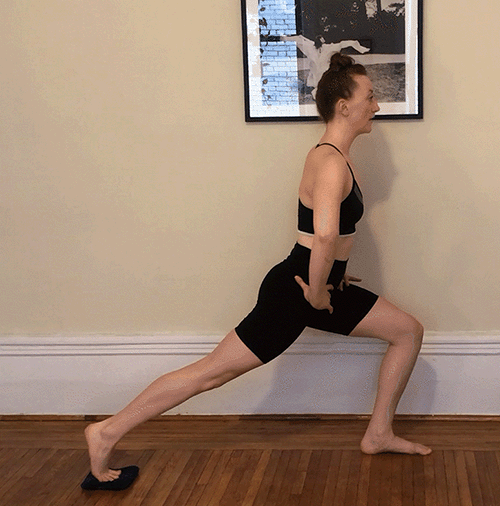
Start standing, with the ball of one foot on a towel.
Bend the standing knee, sliding the foot on the towel back into a lunge position with the knee extended.
Staying low on the standing leg, bend the back knee and drag the back foot in to meet the standing foot, then send it back out.
Squeeze the glutes and push down through the standing foot to return to the starting position. That’s one rep.
Repeat for 1-3 sets of 6-10 reps.
Tips and tricks:
Your main challenges here are keeping the hips square and the standing knee tracking over the toe. If you find your hips rotating, or the standing knee falling in, think of pushing the knee out.
Why it works for dancers:
This exercise is great for building the single-leg stability dancers need for balancing, turning and big weight shifts. It also helps build strength and control in the abductors, the hip muscles partly responsible for turnout as well as single-leg balances and keeping the knees aligned over the toes.
5. Gliding side lunge
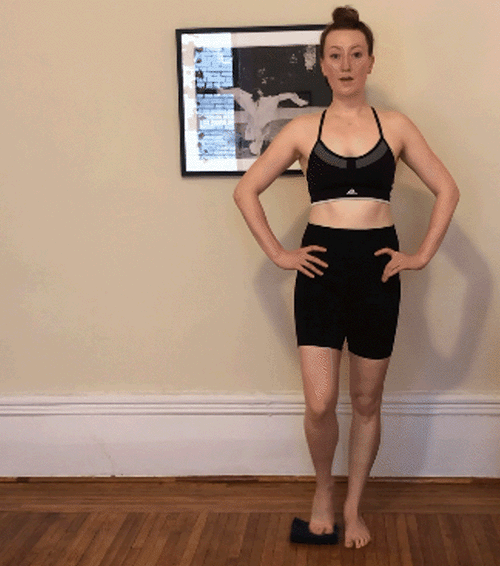
Start standing, with the ball of one foot on a towel.
Bend the standing knee and send the hips back, sliding the foot on the towel out to the side, keeping that knee straight.
Squeeze the glutes and push down through the standing foot to return to the starting position.
Repeat for 1-3 sets of 8-12 reps.
Tips and tricks:
Like the reverse lunge, your main challenges here are to keep the hips square and the working knee over the toe—but now you’re moving in a different plane. It’s generally more challenging to keep the knee over the toe in this exercise, so really think of pushing that knee out.
Why it works for dancers:
In addition to working your abductors (the muscles on the outside of the hip), side lunges also work your adductors (inner thigh muscles). This is great for injury prevention and single-leg stability in all planes of motion.
6. Around the worlds

Start in a partial squat position, knee slightly bent and hips hinged back, with one foot flat on the floor and the ball of the other foot on a towel.
Extend the foot on the towel forward until the leg is straight. Keeping the leg straight, draw a big half circle to the side, then back, then reverse the half circle, returning to the front. That’s one rep.
Keep circling while maintaining your half squat position on the other leg—don’t stand up in between circles.
Repeat 8 times for 1-3 sets.
Tips and tricks:
Again, this is all about hip and knee stability. Think of it like a ronde de jambe but with the leg parallel. Work to keep your standing side totally still—no movement of the pelvis or standing knee. Usually the hardest spot is circling from back to side. You should feel the burn in your standing glute.
Why it works for dancers:
This is a great workout finisher, to challenge your hip stability and control when the muscles are already slightly fatigued. If you find your hips swimming around in ronde de jambe, or generally have trouble keeping your hips square, this is the exercise for you.
